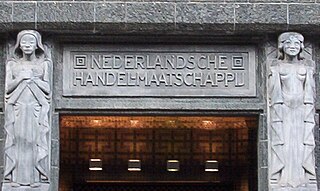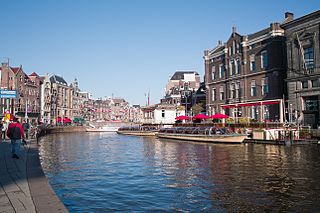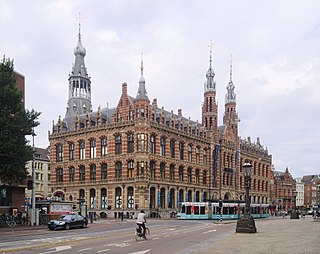
De Bazel is a listed/protected historic building on the west side of the Vijzelstraat in Amsterdam (at number 32), and stretches from the Herengracht to the Keizersgracht. It stands as an example of Brick Expressionism.

De Bazel is a listed/protected historic building on the west side of the Vijzelstraat in Amsterdam (at number 32), and stretches from the Herengracht to the Keizersgracht. It stands as an example of Brick Expressionism.

The building was the most important work of the Dutch architect Karel de Bazel and was built from 1919 to 1926 as the head office of the Nederlandsche Handel-Maatschappij (NHM). [1] The architect died in 1923, three years before completion. Construction was continued by his chef de bureau C. van de Linde, together with designer Adolf Leonard van Gendt. Sculptures on the outside of the building are by Joseph Mendes da Costa, Lambertus Zijl and Hendrik A. van den Eijnde. The stained glass windows were made by Joep Nicolas after designs by Antoon Derkinderen. The building was titled De Spekkoek, after the Dutch-Indonesian delicacy spekkoek, but is now named after the architect.

The building commemorates the history of the NHM and specifically the heroic deeds of the three colonial generals J. P. Coen, Daendels, and J. B. van Heutsz.
De Bazel served as main office of the NHM, then the Algemene Bank Nederland and the Dutch bank ABN AMRO. In 1999 the city of Amsterdam bought the building. After renovation, the building re-opened on 7 August 2007 to house the Amsterdam City Archives (Stadsarchief Amsterdam). It is open to the public. The building also houses the Bureau Monumenten & Archeologie (bMA). It was officially opened on 12 September 2007 by Queen Beatrix.

The building has a concrete framing (designed by A.D.N. van Gendt) covered by interchanged layers of brick and granite, which gave rise to its nickname De Spekkoek ("Layer Cake"). In the base, syenite was used. To visually temper these horizontal elements, vertical elements were added to the building's facade. The building is centered on two light-courts, and its inner details bear some resemblance to works of American architects Frank Lloyd Wright and Louis Sullivan. Almost all interior parts of the building, such as floor mosaics, frames of the airducts, telephone booths, room decorations, as well as its furniture, were also designed by de Bazel.
The materials, massing, scale, interior details and exterior sculptures all mark this building as a good, although late, example of the Dutch variety of Brick Expressionism. Though many changes were made to the building much of the interior has remained in its original state, among which the large meeting room on the third floor. The building was declared a monument in 1991.

The Royal Concertgebouw is a concert hall in Amsterdam, Netherlands. The Dutch term "concertgebouw" translates into English as "concert building". Its superb acoustics place it among the finest concert halls in the world, along with Boston's Symphony Hall and the Musikverein in Vienna.

Hollandsche Bank-Unie (HBU) was a second-tier domestic bank in the Netherlands that Deutsche Bank absorbed in 2010. It had a notable international history.

De Surinaamsche Bank is the largest bank in Suriname. It provides retail banking products such as transaction accounts, loans, mortgagees and credit and debit cards as well as business loans.

The Netherlands Trading Society was a Dutch trading and financial company, established in 1824, in The Hague by King William I to promote and develop trade, shipping and agriculture. For the next 140 years the NHM developed a large international branch network and increasingly engaged in banking operations. In 1964, it merged with Twentsche Bank to form Algemene Bank Nederland, itself a predecessor of ABN AMRO.

The Amsterdam School is a style of architecture that arose from 1910 through about 1930 in the Netherlands. The Amsterdam School movement is part of international Expressionist architecture, sometimes linked to German Brick Expressionism.

The Rokin is a canal and major street in the centre of Amsterdam. The street runs from Muntplein square to Dam square. The Rokin canal used to run from Muntplein square to Dam Square, but in 1936, the part between Spui square and Dam Square was filled in. Canal boats are now moored on the remaining part of the water, from the Amstel to Grimburgwal.

Spekkoek is a type of Indonesian layer cake. It was developed during colonial times in the Dutch East Indies. The firm-textured cake is an Indo (Dutch-Indonesian) version of the European multi-layered spit cake. However it is not baked on a rotating spit, and contains a mix of Indonesian spices, such as cardamom, cinnamon, clove, mace and anise. The cake is made of flour and yolk and is rich in butter or margarine.

Algemene Bank Nederland was a Dutch bank that was created in 1964 through the merger of the Netherlands Trading Society with the Twentsche Bank. In 1991, ABN merged with Amsterdamsche en Rotterdamsche Bank to form ABN AMRO.

The Stadsschouwburgof Amsterdam is the name of a theatre building at the Leidseplein in Amsterdam, Netherlands. The building is in the neo-Renaissance style dating back to 1894, and is the former home of the National Ballet and Opera.

Ons' Lieve Heer op Solder is a 17th-century canal house, house church, and museum in the city center of Amsterdam, The Netherlands. The Catholic Church was built on the top three floors of the canal house during the 1660s. It is an important example of a "schuilkerk", or "clandestine church" in which Catholics and other religious dissenters from the seventeenth century Dutch Reformed Church, unable to worship in public, held services. The church has been open as a museum since 28 April 1888, and has 85,000 visitors annually.

The KNSM Island is a man-made island in the Eastern Docklands of Amsterdam. KNSM stands for the Koninklijke Nederlandsche Stoomboot-Maatschappij, the Royal Dutch Steamboat Shipping company which used to have its headquarters and its docks on the island. It is now a large residential area containing modern architecture with a mostly well-off population.

Herman Hendrik Baanders, also known as Hermanus Hendrikus Baanders and H.H. Baanders, was a Dutch architect who was primarily active in Amsterdam.

The National Monument on Dam Square is a 1956 cenotaph in Amsterdam, Netherlands. A national Remembrance of the Dead ceremony is held at the monument every year on 4 May to commemorate the casualties of World War II and subsequent armed conflicts.

The Waag is a 15th-century building on Nieuwmarkt square in Amsterdam. It was originally a city gate and part of the walls of Amsterdam. Later it served as a guildhall, museum, fire station and anatomical theatre, among other things.

Arti et Amicitiae is a Dutch artist's society founded in 1839, and located on the Rokin in Amsterdam. The Society has played a key role in the Netherlands art scene and in particular in the Amsterdam art schools. It was and is to this day a hub for artists and art lovers in the city of Amsterdam. It is a private institution which supports artists, maintains social networks and offers a pension fund. In recent times it has been one of the venues for the 17th edition of the Sonic Acts Festival.

The former Amsterdam Main Post Office, now the Magna Plaza shopping centre, is a monumental building located at Nieuwezijds Voorburgwal 182 in Amsterdam, Netherlands. It was built in 1895–1899 in neo-Gothic and neo-Renaissance style. The building has been a rijksmonument since 9 July 1974, and is part of the Top 100 Dutch heritage sites.

The Shipping House is a building on the western tip of the Waalseiland near Amsterdam harbour that is one of the top 100 Dutch heritage sites and generally regarded as the first true example of the Amsterdam School, a style characterised by "expressive dynamism, lavish ornamentation and colourful embellishments". It is situated on the Prins Hendrikkade and was erected on the spot where Cornelis Houtman's first trip to the East Indies had begun in 1595. The first part was built 1913 - 1916 ; the second part was built 1926 -1928. Originally, it was the headquarters of six leading Amsterdam shipping companies: the Netherlands Steamship Company (SMN), the Royal Packet Navigation Company (KPM), the Java-China-Japan Line (JCJL) and the Royal Dutch Steamboat Company (KNSM) with subsidiary New Rhine Navigation Company (NRM) and acquired in 1912 Royal West India Mail Service (KWIM).

Karel Petrus Cornelis de Bazel was a modern Dutch architect, engraver, draftsman, furniture designer, carpet designer, glass artist and bookbinding designer. He was the teacher of Adriaan Frederik van der Weij and the first chairman of the Bond van Nederlandse Architecten, beginning in 1909.

Antonius Johannes (Antoon) Derkinderen was a Dutch painter, Glass artist, Draftsman and designer of book covers.

Duin en Kruidberg is a stately home in Santpoort, near Haarlem, the Netherlands. Kruidberg started as a summer house for rich merchants from Amsterdam, then it became a hunting lodge of the prince of Orange, the future king-stadholder, William III (1650–1702). The plans for the Dutch invasion of England were drawn up here, which culminated in the Glorious Revolution of 1688. The estate merged with neighbouring Duin en Berg into Duin en Kruidberg in the 19th century. The current house was constructed by Jacob Theodoor Cremer around 1900 in Dutch Renaissance Revival architecture. The Cremers hosted royalty at the house and held hunting events as well. It was and is one of the largest country houses in the Netherlands. After the Second World War, it became a holiday resort for the employees of a large Dutch bank, ABN AMRO. Later, it was opened for the general public as well.